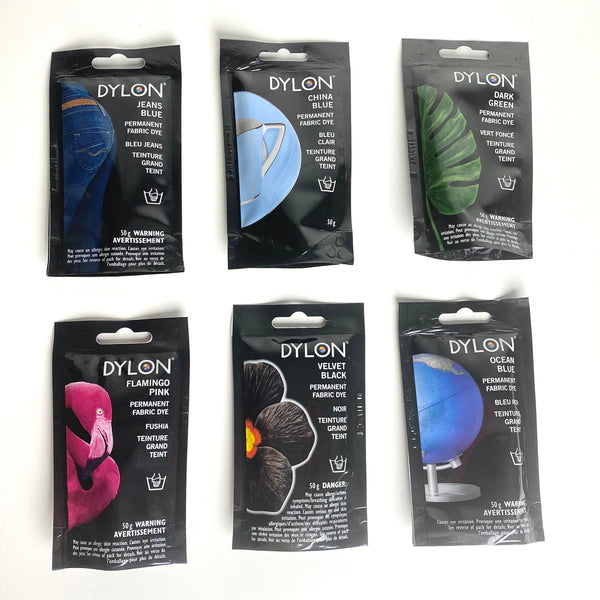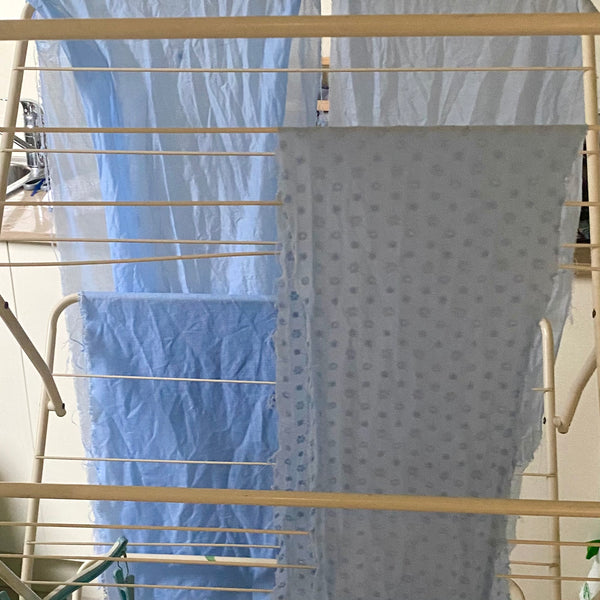Can’t find the perfect fabric colour? Fancy a bit of a holiday project? Why not try dyeing your fabric.
We have a few fabrics suitable for dyeing available at Sewing Gem. This includes linen, voile, cotton broderie and a silk voile blend. Here’s a run down of how well each one took to being dyed.
I decided to use Dylon permanent fabric dye, for hand dyeing, (rather than the washing machine variety). Whilst machine dyeing definitely has its benefits, I find that dyeing by hand provides more control over the intensity of the colour. It’s also a fun activity to get kids involved with!

Here are the fabrics that I decided to dye. From Left to right, white Sophie linen, silk voile blend, white voile and a Lady McElroy broderie anglaise.

Here’s how to dye your fabric. Instructions are also included on the back of the packet.
1. Weigh the dry fabric. One packet of the Dylon hand dye will dye 250g of fabric. As you can see in the photo my fabric weighed 187g. Therefore I used around three quarters of the packet of dye. Alternatively if your fabric weighs less and you decide to use the whole packet the colour intensity will be stronger and vice versa.

2. Wash the fabric thoroughly and leave damp. The picture below shows everything you’ll need to complete the dyeing project. I scrambled this together whilst the fabric was in the wash. The meat thermometer is not essential:) A standard thermometer or just a rough idea of what 40 degrees Celsius feels like (warm) will be good enough. However the salt is essential as this helps the colour hold.

3. Wear rubber gloves and dissolve the dye in 500 ml of warm water, stirring thoroughly.


4. Fill a bowl or steel sink with 6 litres of warm water (40 degrees Celsius).

5. Stir in 5 tablespoons of salt (250g)

6. Add the dye to the mixture and stir well.



7. Submerge fabric in the solution.

8. Stir for 15 mins and then regularly for 45 minutes. And this is what I love about hand dyeing fabric. If you feel at this point that the colour is too dark then whip it out now. Alternatively perhaps you are wanting a deeper colour, then leave it a little longer. Bear in mind that it will lighten slightly when you rinse and wash the fabric.

9. Rinse fabric in cold water until the water runs clear and then wash in warm water.


10. Dry away from direct sunlight or heat.

Part of the reason for writing this blog was to show you how each of the fabrics took the dye. As you can see from the drying photo above despite undergoing the same dyeing process they are all very slightly different shades of china blue. And this is worth considering when you choose the fabric that you want to dye.
I was actually quite impressed with how evenly the colour took for all of the fabrics, although I did follow the instructions to the letter. For me the fabric that resulted in the strongest colour of ‘china blue’ was the voile. The creamy base tone of the silk/voile gave the finished colour a softer feel.
Fabrics are in the same order as before, left to right, linen, silk voile, voile and broderie anglaise.

Do make sure that when you're dyeing broderie that your are using a 100% cotton fabric. If the embroidery is polyester it won’t take the dye.
There are lots of suitable fabrics for dyeing. The back of the packet lists the following:
- Cotton, linen, viscose, rayon, ramie.
- Wool, silk, poly/cotton and poly/viscose mixes will dye to lighter shades.
- Pure polyester, acrylic, nylon and fabric with special finishes will not dye.
- Wash dyed fabric/garment separately for first few washes to ensure dye does not run on to other garments.
Good luck and happy dyeing!!
